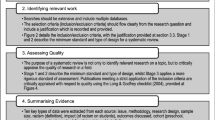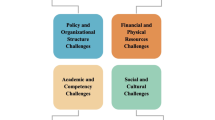Abstract
China is now the second most popular destination country for African international students. This paper investigates the discourse surrounding this emergent flow of students, and the main aim is to offer a new means to conceptualize mobility between non-Western nations. The article highlights weaknesses in current postcolonial conceptualizations of student mobility. A key contribution to the literature on international student mobility is that it extends and adapts existing work on the unequal and asymmetrical nature of international student mobility by drawing on the concept of semi-peripheral (post)coloniality, to examine how specific modes of integration into the “world-system” result in particular discursive formations around international student mobility. The main argument is that relative structural positions between the sending region and receiving country are mirrored in discourse around international student mobility, which contains examples of civilizational paternalism and pursuit of pragmatic foreign policy goals.
Similar content being viewed by others
References
Altbach, P. G. (2007). Globalization and the university: realities in an unequal world. In J. J. F. Forest & P. G. Altbach (Eds.), International handbook of higher education (pp. 121–139). Dordrecht: Springer Netherlands.
Bodomo, A. (2018). Is China colonizing Africa? Africa–China relations in a shifting global economic governance system. In S. Raudino & A. Poletti (Eds.), Global economic governance and human development. London: Routledge.
Bolsmann, C., & Miller, H. (2008). International student recruitment to universities in England: Discourse, rationales and globalisation. Globalisation, Societies and Education, 6(1), 75–88.
Brigety, R. (2019, August 15). A Post-American Africa. Foreign Affairs. https://www.foreignaffairs.com/articles/africa/2018-08-28/post-american-africa. Accessed 11 Dec 2019.
Chan, S.-J. (2012). Shifting patterns of student mobility in Asia. Higher Education Policy, 25(2), 207–224.
Choudaha, R. (2017). Three waves of international student mobility (1999–2020). Studies in Higher Education, 42(5), 825–832.
Connell, R. (2017). Southern theory and world universities. Higher Education Research & Development, 36(1), 4–15.
De Wit, H. (2018). The new dynamics in international student circulation. University World News. Retrieved from https://www.universityworldnews.com/post.php?story=20180704143553337. Accessed 2 Jan 2020.
Ernst and Young. (2019). EY attractiveness program Africa. Ernst and Young. https://www.ey.com/Publication/vwLUAssets/ey-africa-attractiveness-survey-2018/$File/ey-africa-attractiveness-survey-2018.pdf. Accessed 12 Jan 2020.
Forum in China-Africa Cooperation (FOCAC). (2018). African students set their sights on China. Retrieved from https://www.focac.org/eng/zfgx_4/rwjl/t1602757.htm. Accessed 11 Feb 2020.
Forum in China-Africa Cooperation (FOCAC). (2019a). Feature: Chinese scholarships offer hope for Nigerian beneficiaries. Retrieved from https://www.focac.org/eng/zfgx_4/rwjl/t1688065.htm. Accessed 14 Feb 2020.
Forum in China-Africa Cooperation (FOCAC). (2019b). Scholarships help cultivate future leaders of Africa. Retrieved from https://www.focac.org/eng/zfgx_4/rwjl/t1649174.htm. Accessed 18 Dec 2019.
Ginelli, Z. (2018). Hungarian experts in Nkrumah’s Ghana. Mezosfera.Org. Retrieved from http://mezosfera.org/hungarian-experts-in-nkrumahs-ghana/. Accessed 1 Dec 2019.
Griffiths, T. G., & Arnove, R. F. (2015). World culture in the capitalist world-system in transition. Globalisation, Societies and Education, 13(1), 88–108.
Guruz, K. (2008). Higher education and international student mobility in the global knowledge economy. Albany, NY: State University of New York Press.
Ho, E. L. E. (2017). The geo-social and global geographies of power: Urban aspirations of ‘worlding’ African students in China. Geopolitics, 22(1), 15–33.
Ivancheva, M. (2019). Paternalistic internationalism and (de)colonial practices of Cold War higher education exchange: Bulgaria’s connections with Cuba and Angola. Journal of Labor and Society, 22(4), 733–748.
Ivancheva, M., & Syndicus, I. (2019). Introduction: Higher education reform in the ‘periphery’. Learning and Teaching, 12(1), 1–16.
King, K. (2014). China’s higher education engagement with Africa: a different partnership and cooperation model? In G. Carbonnier, M. Carton, & K. King (Eds.), Education, learning, training: critical issues for development. Leiden: Brill Nijhoff.
Koh, S. Y. (2015). Postcolonial approaches to migration in Asia: Reflections and projections. Geography Compass, 9(8), 432–444. https://doi.org/10.1111/gec3.12226.
Lomer, S. (2017a). Recruiting international students in higher education. Berlin Heidelberg: Springer.
Lomer, S. (2017b). Soft power as a policy rationale for international education in the UK: A critical analysis. Higher Education, 74(4), 581–598.
Madge, C., Raghuram, P., & Noxolo, P. (2009). Engaged pedagogy and responsibility: A postcolonial analysis of international students. Geoforum, 40(1), 34–45.
Madge, C., Raghuram, P., & Noxolo, P. (2015). Conceptualizing international education: From international student to international study. Progress in Human Geography, 39(6), 681–701.
Marginson, S. (2008). Global field and global imagining: Bourdieu and worldwide higher education. British Journal of Sociology of Education, 29(3), 303–315.
Marginson, S. (2011). Global position and position-taking in higher education: the case of Australia. In S. Marginson, S. Kaur, & E. Sawir (Eds.), Higher education in the Asia-Pacific: strategic responses to globalization (pp. 375–392). Dordrecht: Springer Netherlands.
McClintock, A. (1992). The angel of progress: Pitfalls of the term ‘post-colonialism’. Social Text, 31/32, 84–98 JSTOR.
Ministry of Education. (2015). 北京大学完善来华留学管理服务 开创留学生教育新局面 [Peking University improves the management service for international students in China and creates a new situation for the education of international students]. Retrieved from http://www.moe.gov.cn/jyb_xwfb/s6192/s133/s134/201502/t20150211_185795.html. Accessed 20 Jan 2020.
Ministry of Education. (2017a). 与46个国家和地区学历学位互认!“一带一路”教育在行动 [Academic degree mutual recognition with 46 countries and territories! “One Belt One Road” education in action]. Retrieved from http://www.moe.edu.cn/s78/A20/moe_863/201706/t20170620_307369.html. Accessed 18 Jan 2020.
Ministry of Education. (2017b). 学校招收和培养国际学生管理办法 [Management methods for the enrollment and training of international students in schools]. Retrieved from http://www.moe.gov.cn/srcsite/A02/s5911/moe_621/201705/t20170516_304735.html. Accessed 10 Jan 2020.
Ministry of Education. (2018). 来华留学生高等教育质量规范(试行)[Quality standards for international students in higher education institutions (Draft)]. Retrieved from http://www.moe.gov.cn/srcsite/A20/moe_850/201810/t20181012_351302.html. Accessed 2 Jan 2020.
Ministry of Education. (2019). 2018来华留学生简明统计 [Concise Statistics on International Students Studying in China in 2018]. 教育部国际合作与交流司 [Department of International Exchange and Cooperation of the Ministry of Education].
Ministry of Foreign Affairs (MOFA). (2006). China’s African Policy. Ministry of foreign affairs. Retrieved from https://www.fmprc.gov.cn/zflt/eng/zgdfzzc/t481748.htm. Accessed 2 Jan 2020.
Ministry of Foreign Affairs (MOFA). (2015). The Forum on China-Africa Cooperation Johannesburg Action Plan (2016–2018). Retrieved from https://www.fmprc.gov.cn/mfa_eng/zxxx_662805/t1323159.shtml. Accessed 10 Jan 2020.
Ministry of Foreign Affairs (MOFA). (2017). Waiti: Zhongguo chaoyue meiying cheng feizhou liuxuesheng zhuyao liuxuedi (Foreign media: China surpasses the United States and Britain to become the main place for African students to study abroad) Retrieved from https://www.fmprc.gov.cn/zflt/chn/zfgx/t1474801.htm. Accessed 1 Feb 2020.
Mohan, G., & Lampert, B. (2013). Negotiating China: reinserting African agency into China–Africa relations. African Affairs, 112(446), 92–110.
Mulvey, B. (2019). International higher education and public diplomacy: a case study of Ugandan graduates from Chinese universities. Higher Education Policy. https://doi.org/10.1057/s41307-019-00174-w.
OECD. (2014). Education at a glance 2014: highlights. OECD publishing. Retrieved from http://www.oecd-ilibrary.org/education/education-at-a-glance-2014_eag_highlights-2014-en. Accessed 10 Jan 2020.
Pezzini, M. (2012). An emerging middle class. OECD Observer. Retrieved from http://oecdobserver.org/news/fullstory.php/aid/3681/An_emerging_middle_class.html. Accessed 18 Dec 2020.
Pugach, S. (2019). Eleven Nigerian students in cold war East Germany: Visions of science, modernity, and decolonization. Journal of Contemporary History, 54(3), 551–572.
Raghuram, P. (2013). Theorising the spaces of student migration. Population, Space and Place, 19(2), 138–154.
Raghuram, P., Noxolo, P., & Madge, C. (2014). Rising Asia and postcolonial geography: Rising Asia and postcolonial geography. Singapore Journal of Tropical Geography, 35(1), 119–135.
Six, C. (2009). The rise of postcolonial states as donors: A challenge to the development paradigm? Third World Quarterly, 30(6), 1103–1121.
Song, Y. (2019). ‘Uneven consequences’ of international English-medium-instruction programmes in China: A critical epistemological perspective. Journal of Multilingual and Multicultural Development, 1–15. https://doi.org/10.1080/01434632.2019.1694525.
Stein, S., & de Andreotti, V. O. (2016). Cash, competition, or charity: International students and the global imaginary. Higher Education, 72(2), 225–239.
Tian, M., & Lowe, J. (2018). International student recruitment as an exercise in soft power: a case study of undergraduate medical students at a Chinese University. In F. Dervin, X. Du, & A. Härkönen (Eds.), International students in China (pp. 221–248). Cham: Springer International Publishing.
United Nations Educational, Scientific and Cultural Organization (UNESCO). (2019). Global flow of tertiary-level students. Retrieved from http://uis.unesco.org/en/uis-student-flow. Accessed 20 Jan 2020.
Wallerstein, I. (1995). After liberalism. New York: New Press.
Wallerstein, I. M. (2004). World-systems analysis: an introduction. Durham: Duke University Press.
Wang, L. (2014). Internationalization with Chinese characteristics. Chinese Education & Society, 47(1), 7–26.
Waters, J. L. (2006). Geographies of cultural capital: Education, international migration and family strategies between Hong Kong and Canada. Transactions of the Institute of British Geographers, 31(2), 179–192.
Wu, H. (2019). Three dimensions of China’s “outward-oriented” higher education internationalization. Higher Education, 77(1), 81–96.
Yang, P. (2019). Toward a framework for (re)thinking the ethics and politics of international student mobility. Journal of Studies in International Education. https://doi.org/10.1177/1028315319889891.
Ziguras, C., & McBurnie, G. (2011). International student mobility in the Asia-Pacific: from globalization to regional integration? In S. Marginson, S. Kaur, & E. Sawir (Eds.), Higher education in the Asia-Pacific: strategic responses to globalization (pp. 123–140). Dordrecht: Springer Netherlands.
Author information
Authors and Affiliations
Corresponding author
Ethics declarations
Conflict of interest
The authors declare that they have no conflicts of interest.
Additional information
Publisher’s note
Springer Nature remains neutral with regard to jurisdictional claims in published maps and institutional affiliations.
Rights and permissions
About this article
Cite this article
Mulvey, B. Conceptualizing the discourse of student mobility between “periphery” and “semi-periphery”: the case of Africa and China. High Educ 81, 437–451 (2021). https://doi.org/10.1007/s10734-020-00549-8
Published:
Issue Date:
DOI: https://doi.org/10.1007/s10734-020-00549-8




